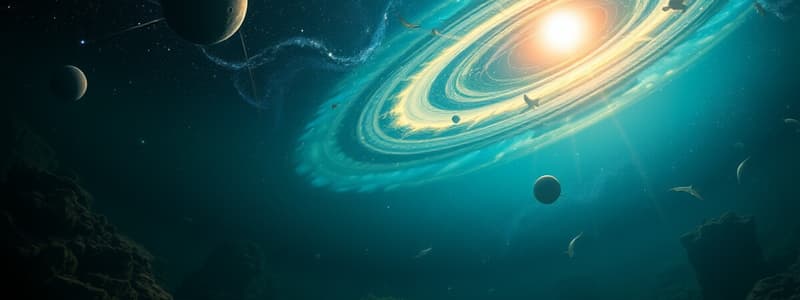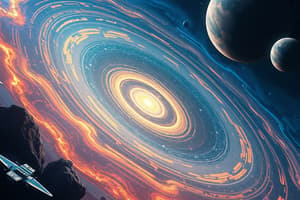Podcast
Questions and Answers
What proportion of Earth's water is considered freshwater?
What proportion of Earth's water is considered freshwater?
- 50%
- 10%
- 26%
- 3% (correct)
What does the Nebular Hypothesis primarily explain?
What does the Nebular Hypothesis primarily explain?
- The origin of black holes
- The nature of gravitational waves
- The lifecycle of stars
- The formation of solar systems (correct)
What is a characteristic of sedimentary rocks?
What is a characteristic of sedimentary rocks?
- Formed by volcanic activity
- Result from the lithification of weathered particles (correct)
- Composed only of organic materials
- Contain high levels of quartz and feldspar
Which theory suggests that the universe is unchanging over time?
Which theory suggests that the universe is unchanging over time?
What must be true about a planet's distance from its star?
What must be true about a planet's distance from its star?
What is the primary reason that too long diurnal temperature changes would be detrimental to life?
What is the primary reason that too long diurnal temperature changes would be detrimental to life?
Which layer of the atmosphere contains the majority of the water vapor?
Which layer of the atmosphere contains the majority of the water vapor?
What defines igneous rocks?
What defines igneous rocks?
Which component is NOT one of the reasons contributing to our planet's habitability?
Which component is NOT one of the reasons contributing to our planet's habitability?
Which of the following is NOT a category of rock?
Which of the following is NOT a category of rock?
Flashcards are hidden until you start studying
Study Notes
Nebular Hypothesis
- Solar Nebular Disk Model describes the early formation of the solar system from a rotating disk of gas and dust.
Crust
- Earth's outermost layer consisting of diverse igneous, metamorphic, and sedimentary rocks.
Solar System
- Comprises eight planets and their moons, all orbiting the Sun.
Aquatic Biomes
- Divided into freshwater biomes (ponds, lakes, rivers) and marine biomes (oceans, estuaries).
Hydrosphere
- Contains 97% saltwater and 3% freshwater.
Biosphere
- Encompasses all life forms on Earth.
Mormon Cosmology
- Proposes the existence of pre-mortal life and that human spirits are children of heavenly parents.
Planetary Distance from a Star
- A planet's habitable conditions depend on its distance from a star, affecting temperature extremes.
Vortex Theory
- Suggests the solar system formed from swirl-like motions of pre-solar materials, leading to circular orbits.
Steady State Theory
- Claims the universe is eternally unchanging and uniform; proponents include Fred Hoyle, Thomas Gold, and Hermann Bondi.
Universe
- Defined as the entirety of space, time, and all matter and energy within it.
Religious Cosmology
- Based on specific creation myths and acts of creation by a deity.
Big Bang Theory
- Proposes the universe originated from a singular point and expanded after a massive collision.
Sedimentary Rocks
- Formed through lithification of weathered particles from pre-existing rocks.
Crystal Structure
- Characterizes minerals by a specific, ordered internal arrangement.
Petroleum
- Derives from Latin words meaning "rock" (petra) and "oil" (oleum).
Minerals
- Naturally occurring, inorganic solids with a defined chemical composition and crystalline structure.
Coal
- A combustible rock primarily composed of carbon, with hydrogen, oxygen, nitrogen, and sulfur.
Planetary Rotation Effects
- Short rotation leads to high atmospheric wind velocities; long rotation results in excessive temperature variations unsuitable for life.
Igneous Rocks
- Created through the cooling and solidification of magma or lava.
Buddhist Cosmology
- Attributes the universe's existence to the actions and karma of its inhabitants.
Salinity
- Measures the amount of dissolved salts in water.
Troposphere
- The atmosphere's lowest layer, containing about 80% of its total mass and most water vapor.
Abundant Gases
- Hydrogen is the most prevalent gas in the universe; nitrogen is the most common gas in Earth's atmosphere.
Habitable Planet Criteria
- Key factors for habitability include distance from a star, terrestrial conditions, orbital eccentricity, axial tilt, rotation speed, and geochemistry.
Rock Categories
- Three main rock types: sedimentary, igneous, and metamorphic.
Atmospheric Layers
- Composed of the geosphere, atmosphere, hydrosphere, and biosphere.
Studying That Suits You
Use AI to generate personalized quizzes and flashcards to suit your learning preferences.




